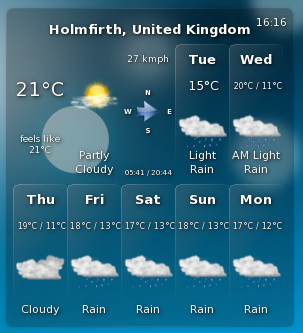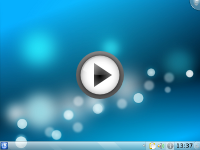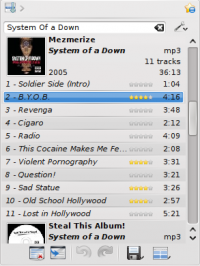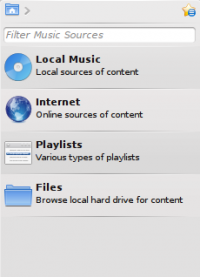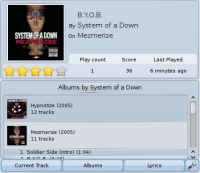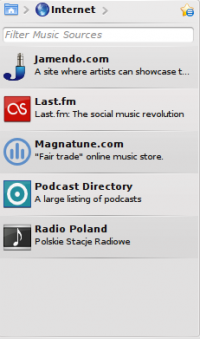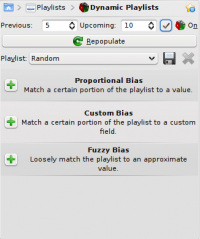User:Annew: Difference between revisions
The madman (talk | contribs) No edit summary |
mNo edit summary |
||
| Line 76: | Line 76: | ||
</div> | </div> | ||
Amarok 2 has the most configurable playlist of any music player in existence. While most offer a columnar layout as default and perhaps a few other fixed views for the playlist, Amarok2 puts the power in your hands to shape the playlist any way you see fit. To start you off, there are three example playlist layouts that you can use as starting points to create the layout that fits your flow the best.</div> | Amarok 2 has the most configurable playlist of any music player in existence. While most offer a columnar layout as default and perhaps a few other fixed views for the playlist, Amarok2 puts the power in your hands to shape the playlist any way you see fit. To start you off, there are three example playlist layouts that you can use as starting points to create the layout that fits your flow the best.</div> | ||
--------------- | |||
{{Template:I18n/Language Navigation Bar|Amarok}} | |||
{| | |||
|[[Image:Amarok icon.png|64px|left|Amarok]]|| ||'''Amarok is a music manager for KDE''' | |||
|} | |||
Amarok is a free, versatile and powerful music player for linux. The latest 2.x release series, often referred to as "Amarok 2", is cross-platform (can be used on many platforms including linux, mac and windows) and implements a completely reworked codebase that will enable it to incorporate exciting new features as the release matures. The current stable release is version 2.1.0. | |||
==Interface== | |||
Amarok 2 sports a three-pane interface by default. | |||
===The left pane=== | |||
<div style="overflow:auto;"><div style="float:left; border:1px solid lightgray; margin-right:5px;" cellpadding="5"> | |||
[[Image:Amarok2.1left.png|thumb|200px|left|"To the left, we have..."]] | |||
</div> | |||
The left pane is tabbed and retractable. The first tab is the collection browser, which is the primary interface to your local collection. Attached devices will also show up here. There is a tab for all internet services that you have enabled. Here, you can browse listings of radio stations and podcasts; listen/subscribe to them, interact with your last.fm account, purchase music from online stores such as Magnatune and download independent artists' music from Jamendo and more. The Playlist tab allows you to create and manage dynamic and traditional playlists and podcasts. Finally, the files tab displays an integrated file browser. | |||
===The central pane (Context View)=== | |||
<div style="overflow:auto;"><div style="float:left; border:1px solid lightgray; margin-right:5px;" cellpadding="5"> | |||
[[Image:Amarok2.1center.png|thumb|200px|right|"In the middle..."]] | |||
</div> | |||
This is where all the action is. The pane contain applets that dynamically change to display context information about the song that is currently playing. You can see the rating, score and playcount of the currently playing song, other songs by the same artist that you have, the lyrics of the song, the wikipedia page on the artist and more. These applets can be added, removed or rearranged using the applet bar at the bottom of the pane. | |||
===The right pane (Playlist View)=== | |||
<div style="overflow:auto;"><div style="float:right; border:1px solid lightgray; margin-left:5px;" cellpadding="5"> | |||
[[Image:Amarok2.1right.png|thumb|200px|left|"And on the right..."]] | |||
</div> | |||
Amarok 2 has the most configurable playlist of any music player in existence. While most offer a columnar layout as default and perhaps a few other fixed views for the playlist, Amarok2 puts the power in your hands to shape the playlist any way you see fit. To start you off, there are three example playlist layouts that you can use as starting points to create the layout that fits your flow the best. | |||
== Features == | |||
===Plays music :)=== | |||
[[Image:Amarok2.1svn965006.png|thumb|500px|center|"Listening to The Rain Song"]] | |||
<!-- [[Image:Amarok2.png|thumb|250px|center|Amarok 2 plays a song]] --> | |||
<!-- [[Image:Amarok-screenshot.jpg|thumb|250px|center|Amarok 3.5 -- ]] --> | |||
Amarok 2 can support most popular formats for music files. The actual list of formats is dependent on the codecs and audio backend in use on your system. There's also support for traditional playlists - you can create, save and load all the playlists you want. | |||
===Device Support=== | |||
[[Image:Amarok2.1ipod.png|thumb|500px|center|"There's my iPod"]] | |||
Currently, basic iPod and MTP device support are enabled if the required packages are installed. This will be improved upon and more devices will be supported in the future releases. | |||
===Configurable Context View=== | |||
[[Image:Amarok2.1contextviewconfig.png |thumb|500px|center|"Custom context view"]] | |||
The centerpiece attraction in Amarok 2, the context view can automatically fetch contextual information about the currently playing song (such as album art, lyrics or Wikipedia information) from the internet and display them. This is one of the unique features of the Amarok series. | |||
===More Internet Services=== | |||
<div style="overflow:auto;"><div style="float:left; border:1px solid lightgray; margin-right:5px;" cellpadding="5"> | |||
[[Image:Amarok2.1internetservices.png|thumb|200px|left|"Some internet services shown on the left pane"]] | |||
</div> | |||
Amarok 2 opens the gateway to a rich multimedia experience on the internet. Sporting interfaces to services such as Ampache music servers and mp3tunes lockers, it allows you to listen to your music from anywhere in the world. You can sample and buy music from Magnatune. Using the Jamendo service, you can listen to and download music from independent artists who you can support with your donations. With integrated last.fm functionality, you can scrobble your tracks, use last.fm features like statistics, charts and listen to radio streams customized to your music taste all from Amarok 2. And that's just the beginning - you can add even more internet services using the Script Manager. | |||
===Script Manager=== | |||
[[Image:Amarok2.1scriptmanager.png|thumb|500px|center|"I know Script fu!"]] | |||
Scripts are add-ons that allow you to extend Amarok 2's functionality in innovative ways. Using the Script Manager, you can manage these scripts by allowing you to install/remove or enabling/disabling scripts you already have. You can also use the "Get More Scripts" feature to download new scripts submitted by other users. | |||
===Cover Manager=== | |||
[[Image:Amarok2.1covermanager.png|thumb|500px|center|"Browsin' the covers"]] | |||
You can browse through your music collection using the nifty cover manager that displays the album art. | |||
===Rating and scoring=== | |||
[[Image:Amarok2.1rating.png|thumb|500px|center|"But...But, I LOVE The Rain Song!"]] | |||
You can show your love for the songs by rating them. Amarok 2 supports 1/2 star ratings, too. In addition, Amarok 2 can calculate a score (a sort of guessed rating) depending on metrics such as how often you listen to or skip a song. | |||
===Pop-Up Dropper=== | |||
[[Image:Amarok2.1popup.png|thumb|500px|center|"Or you could right-click, but this is cooler!"]] | |||
This is an innovative interface that offers contextual options (such as the ones you see in a right-click menu) that you can "drop" a song into. Grab a song and see it appear in the context view pane! | |||
===Configurable Playlist View=== | |||
[[Image:Amarok2.1pleditor.png|thumb|500px|center|"The Playlist Layout Editor is flat-out awesome!"]] | |||
The currently loaded playlist is highly configurable and can show information about the songs in any form you like. If you prefered the "spreadsheet-view" found in Amarok 1.x series and other music players, you can have that, too! The Playlist View also allows you to save or export the current playlist. | |||
===Dynamic Playlists=== | |||
<div style="overflow:auto;"><div style="float:left; border:1px solid lightgray; margin-right:5px;" cellpadding="5"> | |||
[[Image:Amarok2.1dynamicplaylist.png|thumb|200px|left|"A little bit of this, a little bit of that..."]] | |||
</div> | |||
Amarok 2 allows you to create weighted random playlists that adhere to various criteria exactly ("Proportional bias") or approximately ("Fuzzy bias"). For example, you can create a playlist that's randomly populated by songs that are rated more than 3 stars and are approximately from around the year 1967! | |||
===Replay Gain Support=== | |||
Amarok 2 supports replay gain tag information embedded in files and automatically adjusts the overall volume of the song to a common level. | |||
Rediscover your music! | |||
==Hints, Tips and FAQs== | |||
* If you find that most of your music is recognised by Amarok, but some folders are not properly picked up, open a console and type <tt>touch ''folder''</tt> where <tt>''folder''</tt> is the path to the folder that has the problem. In Amarok, You then select the ''Settings > Configure Amarok > Collection > Rescan Collection'' option. Now Your folder should be seen. | |||
== More Information == | |||
* [http://amarok.kde.org/ Amarok Homepage] | |||
* [http://amarok.kde.org/forum/ Amarok Forum] | |||
---- | ---- | ||
Revision as of 18:41, 20 September 2009
Saved for re-use: Template:I18n/Language Navigation Bar
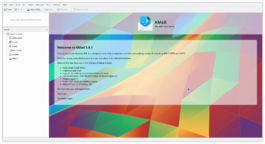 |
KMail is the email component of Kontact, the integrated personal information manager of KDE. |
Image map:
KWord
|
kwrite ftp://ftp.kde.org/pub/kde/Welcome.msg |
![]() Support for this application can be found from the project's home page
Support for this application can be found from the project's home page
Template:I18n/Language Navigation Bar
| Amarok is a music manager for KDE |
Amarok is a free, versatile and powerful music player for linux. The latest 2.x release series, often referred to as "Amarok 2", is cross-platform (can be used on many platforms including linux, mac and windows) and implements a completely reworked codebase that will enable it to incorporate exciting new features as the release matures. The current stable release is version 2.1.0.
Interface
Amarok 2 sports a three-pane interface by default.
The left pane
The left pane is tabbed and retractable. The first tab is the collection browser, which is the primary interface to your local collection. Attached devices will also show up here. There is a tab for all internet services that you have enabled. Here, you can browse listings of radio stations and podcasts; listen/subscribe to them, interact with your last.fm account, purchase music from online stores such as Magnatune and download independent artists' music from Jamendo and more. The Playlist tab allows you to create and manage dynamic and traditional playlists and podcasts. Finally, the files tab displays an integrated file browser.
The central pane (Context View)
This is where all the action is. The pane contain applets that dynamically change to display context information about the song that is currently playing. You can see the rating, score and playcount of the currently playing song, other songs by the same artist that you have, the lyrics of the song, the wikipedia page on the artist and more. These applets can be added, removed or rearranged using the applet bar at the bottom of the pane.
The right pane (Playlist View)
Amarok 2 has the most configurable playlist of any music player in existence. While most offer a columnar layout as default and perhaps a few other fixed views for the playlist, Amarok2 puts the power in your hands to shape the playlist any way you see fit. To start you off, there are three example playlist layouts that you can use as starting points to create the layout that fits your flow the best.
Features
Plays music :)
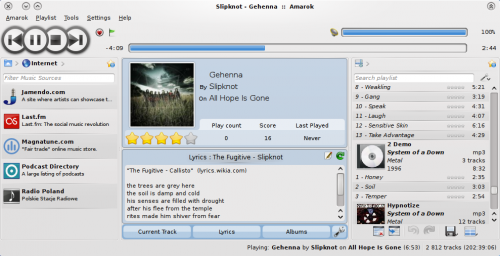
Amarok 2 can support most popular formats for music files. The actual list of formats is dependent on the codecs and audio backend in use on your system. There's also support for traditional playlists - you can create, save and load all the playlists you want.
Device Support
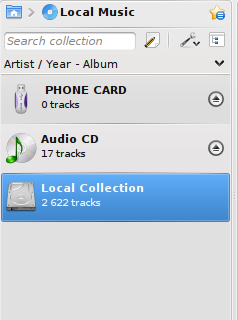
Currently, basic iPod and MTP device support are enabled if the required packages are installed. This will be improved upon and more devices will be supported in the future releases.
Configurable Context View
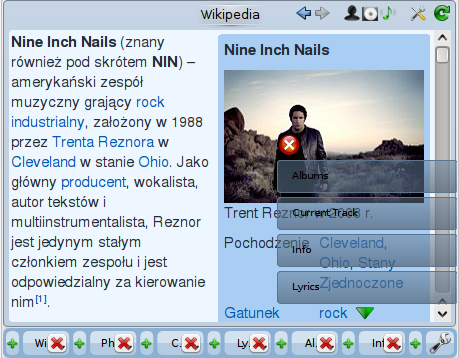
The centerpiece attraction in Amarok 2, the context view can automatically fetch contextual information about the currently playing song (such as album art, lyrics or Wikipedia information) from the internet and display them. This is one of the unique features of the Amarok series.
More Internet Services
Amarok 2 opens the gateway to a rich multimedia experience on the internet. Sporting interfaces to services such as Ampache music servers and mp3tunes lockers, it allows you to listen to your music from anywhere in the world. You can sample and buy music from Magnatune. Using the Jamendo service, you can listen to and download music from independent artists who you can support with your donations. With integrated last.fm functionality, you can scrobble your tracks, use last.fm features like statistics, charts and listen to radio streams customized to your music taste all from Amarok 2. And that's just the beginning - you can add even more internet services using the Script Manager.
Script Manager
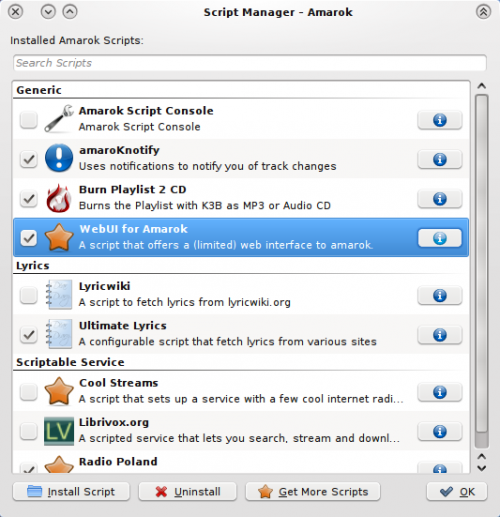
Scripts are add-ons that allow you to extend Amarok 2's functionality in innovative ways. Using the Script Manager, you can manage these scripts by allowing you to install/remove or enabling/disabling scripts you already have. You can also use the "Get More Scripts" feature to download new scripts submitted by other users.
Cover Manager
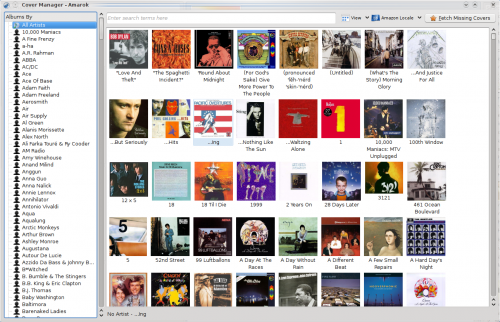
You can browse through your music collection using the nifty cover manager that displays the album art.
Rating and scoring

You can show your love for the songs by rating them. Amarok 2 supports 1/2 star ratings, too. In addition, Amarok 2 can calculate a score (a sort of guessed rating) depending on metrics such as how often you listen to or skip a song.
Pop-Up Dropper
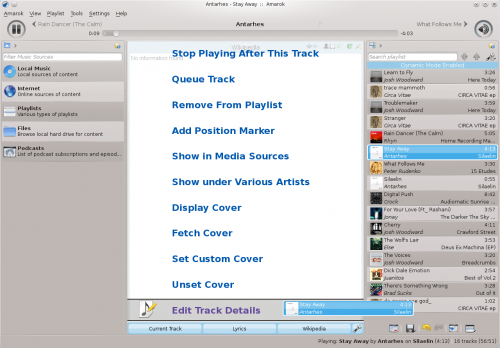
This is an innovative interface that offers contextual options (such as the ones you see in a right-click menu) that you can "drop" a song into. Grab a song and see it appear in the context view pane!
Configurable Playlist View
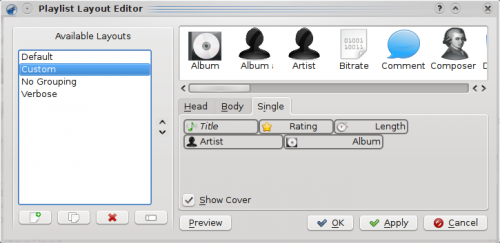
The currently loaded playlist is highly configurable and can show information about the songs in any form you like. If you prefered the "spreadsheet-view" found in Amarok 1.x series and other music players, you can have that, too! The Playlist View also allows you to save or export the current playlist.
Dynamic Playlists
Amarok 2 allows you to create weighted random playlists that adhere to various criteria exactly ("Proportional bias") or approximately ("Fuzzy bias"). For example, you can create a playlist that's randomly populated by songs that are rated more than 3 stars and are approximately from around the year 1967!
Replay Gain Support
Amarok 2 supports replay gain tag information embedded in files and automatically adjusts the overall volume of the song to a common level.
Rediscover your music!
Hints, Tips and FAQs
- If you find that most of your music is recognised by Amarok, but some folders are not properly picked up, open a console and type touch folder where folder is the path to the folder that has the problem. In Amarok, You then select the Settings > Configure Amarok > Collection > Rescan Collection option. Now Your folder should be seen.
More Information
Second Layout Project - for a place or event
Template:I18n/Language Navigation Bar
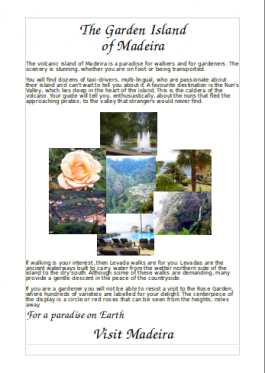 |
In our second Layout Tutorial you will use your own pictures and text |
In this lesson you will revise the steps of the first tutorial:
- add text boxes and adjust their size and position
- format text
- add illustrations
- adjust their size and position
You will create a page suitable for publicising a place or event, positioning and grouping images. We will base this on holiday photos.
Before you start you may find it helpful to create a temporary folder containing all the pictures you intend to use. For the purpose of this tutorial you should scale your pictures to no more than 125mm (5in) wide as inserting large images has an impact on printing time.
As in our first layout project, select the blank page template and adjust your margins.
- For the first part of our album, write your heading as you did before, and a few lines of introductory text.
- Bring in a collection of pictures to make your introductory collage, and arrange them in a cluster. Make them approximately the size you want, but don't worry about being accurate.
- Choose one of the pictures that's approximately the size you want. The geometry of the frame is displayed on the bottom right of your screen. Make a note of the height and width
- On the Geometry tab set the width and height to the size you determined. Do this for every picture, so that they are a matched set for size.

- Now the size of the photos is fixed, check for colour balance - if you have two similar coloured photos, should they be moved to get a better balance?
- We are going to pull the photos in to overlap - you will necessarily lose part of the picture, so are the more boring bits where the overlaps might occur? Move them around, if necessary.
- As you pull them in and can see the overlaps, experiment with layering them - from the menu bar, Frames, Lower Frame, or Raise Frame, until you are happy with the result. Some collections of picture work better than others and you may have to compromise.

- Holding down Ctrl, click on each of the photos, then on the Group icon
 . You will find that you can now move the whole group as one object. Should you wish to make changes, simple use the Ungroup icon
. You will find that you can now move the whole group as one object. Should you wish to make changes, simple use the Ungroup icon  , make your changes, then re-group the photos. In this instance we don't want any text to flow alongside these images, so right-click on the group,and select Frame/Frameset Properties, "Text Runaround' tab, and select "Text will not run around this frame".
, make your changes, then re-group the photos. In this instance we don't want any text to flow alongside these images, so right-click on the group,and select Frame/Frameset Properties, "Text Runaround' tab, and select "Text will not run around this frame".
- Add the rest of your text, and maybe a slogan to end. At this point you may find that you don't like the balance of your page, in which case, drag the photo group around, slowly, watching how your text adapts. When you feel you have the best balance you can manage, you're done.
Plenty of white space is advisable in a photo album page, but if your margins are too large you will find that either the pictures or text suffer from lack of space.
First, create two Image boxes. Place the first just under the title, and touching the right-hand margin. In that one, place a photo that is typical of your destination. Place a feature photo touching the left-hand margin, approximately corner-to-corner with the first photo.
Now create a text frame,alongside your first picture, roughly filling the availlable space. In Properties, give it a recognisable name, then in the Options tab, set "Do not show the extra text". Close the properties box, and select the Text tool. The text tool options appear at the lower right of the page. Set the font style and size that you want, then either type directly into the box, or paste in ready-made text.
If your text overflows the area selected it will not be visible (due to the setting we just made). Now's the time to create a new text box alongside the second picture. Again, fill the available space. The Connect Text Frames options page will pop up. Click on the named frame you earlier created.




